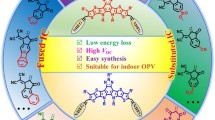Abstract
This paper describes an alternative active layer for the solar cells based on the organometallic compounds in two configurations: bulk heterojunction and donor/acceptor junction between the organometallic compounds as the electron donor and carbon-based layer as the electron acceptor. Both configurations depend on the band alignment which ensures optimal charge transport towards electrodes in the sandwich structures of these active layers, but the optimization also depends by the exciton diffusion length which limits the thicknesses of the active layer. In the bulk heterojunctions, the exciton diffusion length could be extended to 100 nm which allows a better efficiency then bilayer structures. The photoconductive behaviors of these two configurations have shown the superiority of the bulk heterojunctions, increasing the intensity of the measured photocurrent. The redshift of the photoluminescence of Alq3-5Cl in the bulk heterojunctions reveals a better charge transfer towards the acceptor layer, in this case, formed from graphene oxide. The alternative of organometallic compounds as donor materials ensures a better thermal and chemical stability compared with other organic materials like perovskites.
Similar content being viewed by others
References
A. Mehta, S. Yadav, K. Solanki, and C. Joshi, Int. J. Adv. Eng. Tech. 3, 43 (2012).
L. Hardesty, NREL Demos 45.7% efficiency for concentrator solar cell. https://www.energymanagertoday.com/nrel-demos-45-7-efficiency-concentrator-solar-cell-0107550/ Accessed 7 July 2018.
X. Qin, Z. Zhao, Y. Wang, J. Wu, Q. Jiang, and J. You, J. Semicond. 38, 011002 (2017).
D.W. Ayele, W.N. Su, J. Rick, H.M. Chen, C.J. Pan, N.G. Akalework, and B.J. Huang, Advances in Organo-Metallic Chemistry and Catalysis: The Silver/Gold Jubilee International Conference on Organometallic Chemistry Celebratory Book, 1st ed., ed. A.J.L. Pombeiro (Hoboken: Wiley, 2014), p. 503.
I.C. Radu, S. Polosan, I. Enculescu, and H. Iovu, Opt. Mater. 35, 268 (2012).
C.C. Ciobotaru, C.M. Damian, E. Matei, and H. Iovu, Materiale Plastice 51, 75 (2014).
G.I. Titelman, V. Gelman, S. Bron, R.L. Khalfin, Y. Cohen, and H. Bianco-Peled, Carbon 43, 641 (2005).
C.C. Ciobotaru, S. Polosan, and I.C. Ciobotaru, J. Electr. Mater. 47, 1490 (2018).
M. Pope and C.E. Swenberg, Electronic Processes in Organic Crystals and Polymers (New York: Oxford University Press, 1999), p. 96.
E.A. Silinsh and V. Cápek, Organic Molecular Crystals: Interaction, Localization, and Transport Phenomena (New York: American Institute of Physics, 1994), p. 402.
P. Peumans, A. Yakimov, and S.R. Forrest, J. Appl. Phys. 93, 3694 (2003).
T.B. Fleetham, Z. Wang, and J. Li, Inorg. Chem. 52, 7338 (2013).
B.B. Chen, S. Wang, S.W. Jiang, Z.G. Yu, X.G. Wan, H.F. Ding, and D. Wu, New J. Phys. 17, 013004 (2015).
M.C. Scharber and N.S. Sariciftci, Prog. Polym. Sci. 38, 1929 (2013).
C. Deibel and V. Dyakonov, Rep. Prog. Phys. 73, 096401 (2010).
R. Subodro, B. Kristiawan, A.H. Ramelan, S. Wahyuningsih, H. Munawaroh, Q.A. Hanif, and L.N.M.Z. Saputri, in AIP Conference Proceedings, (2016), pp. 1788
C.C. Ciobotaru, I.C. Ciobotaru, G. Schinteie, R. Negrea, and S. Polosan, Mater. Sci. Semicond. Proc. 72, 78 (2017).
H.B. DeVore, Phys. Rev. 102, 86 (1956).
Acknowledgments
This work was supported by a Grant from the Romanian National Authority for Scientific Research, CNCS-UEFISCDI Core Program PN19-03 (Contract No. 21 N/08.02.2019).
Author information
Authors and Affiliations
Corresponding author
Ethics declarations
Conflict of interest
The authors declare that they have no conflict of interest.
Additional information
Publisher's Note
Springer Nature remains neutral with regard to jurisdictional claims in published maps and institutional affiliations.
Rights and permissions
About this article
Cite this article
Polosan, S., Ciobotaru, C.C. & Ciobotaru, I.C. Charge Transfer from Alq3-5Cl to Graphene Oxide in Donor–Acceptor Heterostructures. J. Electron. Mater. 48, 7184–7191 (2019). https://doi.org/10.1007/s11664-019-07531-w
Received:
Accepted:
Published:
Issue Date:
DOI: https://doi.org/10.1007/s11664-019-07531-w




